India’s iron ore output increased to 143 million tonnes (MT) in the first seven months of the current fiscal year, surpassing the previous high of 246 MT established in 2019-20, according to Mines Secretary Alok Tandon.
Tandon noted on during the International Mining Summit with the theme ‘Towards a Responsible and Competitive Mining Industry,’ organised by industry group CII, that production of another significant commodity, bauxite, also increased Y-o-Y in the April-October period of 2021-22.
“Iron ore output of 143 million tonnes through April to October, that is seven months of 2021-2022, is not only a 50% increase from 95.5 million tonnes in the previous year, but it is also well on its approach to surpassing the record production of 246 MT recorded in 2019-20,” he said.
India is a major producer of minerals including iron ore, zinc, and bauxite, which are essential for rapid industrial development. Despite this, the mining and quarrying industry accounts for just around 2% of the country’s GDP.
He stated that while the entire effects of policy changes cannot be seen in a short period of time, some early trends in mineral production are positive.
The government has taken a number of steps, including legislative moves, to boost this sector’s competitiveness and boost its contribution to the national economy.
Aside from that, numerous measures have been taken to ensure the well-being of the people who live near mining sites and the long-term viability of the ecosystem.
“With results starting to emerge, I believe the conference’s theme is appropriate in this context,” he said.
Several legislative reforms have been implemented in the previous few years, largely through revisions to the MMDR Act, to improve the competitiveness of the Indian mining industry and raise social responsiveness.
While minor adjustments to the MMDR Act were made in 2015 and 2020 to address the changing demands of the mining sector, this year’s revision was more comprehensive, since it was aimed to expand mineral production and availability while also improving the ease of doing business.
Meanwhile, the National Mineral Exploratory Trust was established to provide a boost to exploration operations.
The amendment legislation of 2015, in order to strengthen social trust, permits for the establishment of District Mineral Foundations (DMFs) by state governments in mining-affected regions to care for people harmed by mining operations.
Tandon stated that “some good progress has been made” in regards to DMF; so far, DMFs have been established in 600 districts across 22 states.
The guidelines require that mining licenses awarded previous to 2015 must pay a 30% royalty to DMF, and mining leases granted after 2015 must pay a 10% royalty. “Around Rs 55,000 crore has been collected in the DMF so far,” Tandon said.
You may also like
-
Trade Connect E-platform For Exports Is Single Window, Fast, Accessible And Transformational: Shri Piyush Goyal
-
Dot Simplifies Approval Processes For Telecom Licenses And Wireless Equipment
-
Coal Production and Supply Trends on Positive Trajectory
-
Union Minister To Release Booklets On Promotion Of Indigenous Species & Conservation Of States Fishes
-
2nd India-Japan Finance Dialogue held in Tokyo on 6th September, 2024
